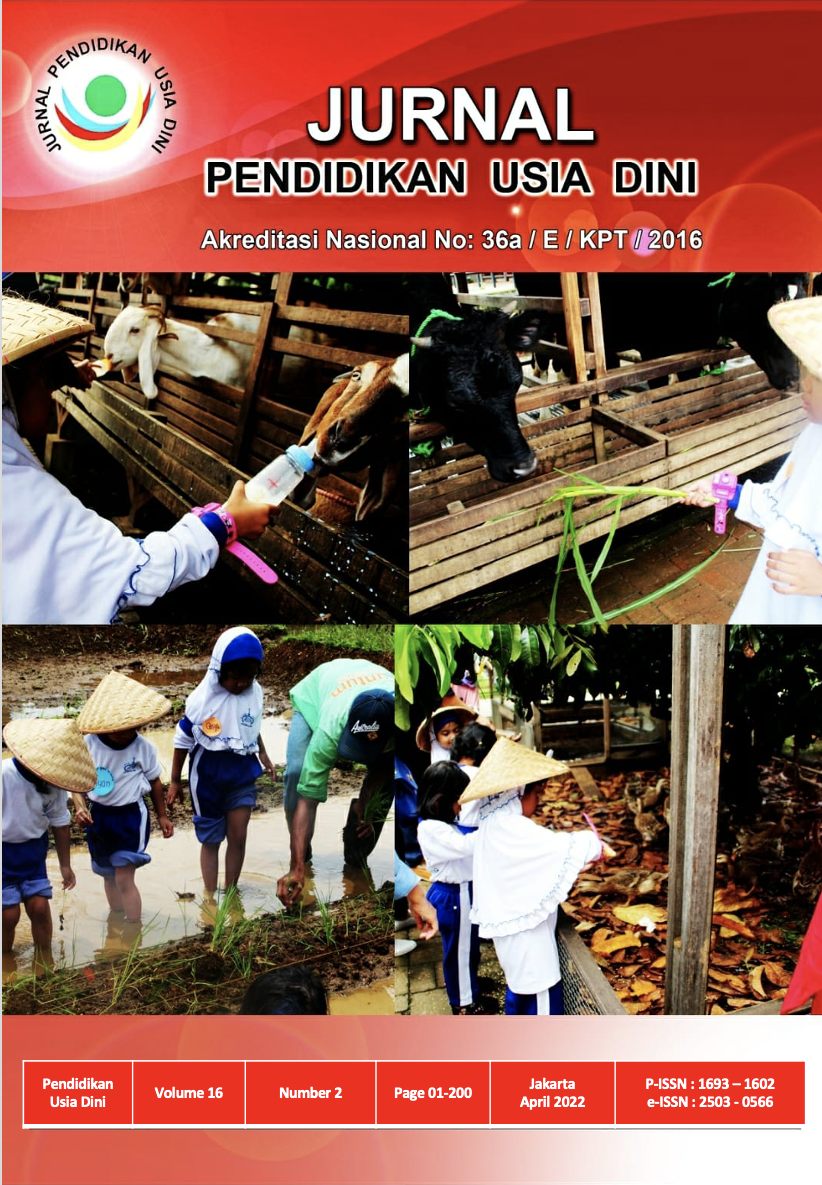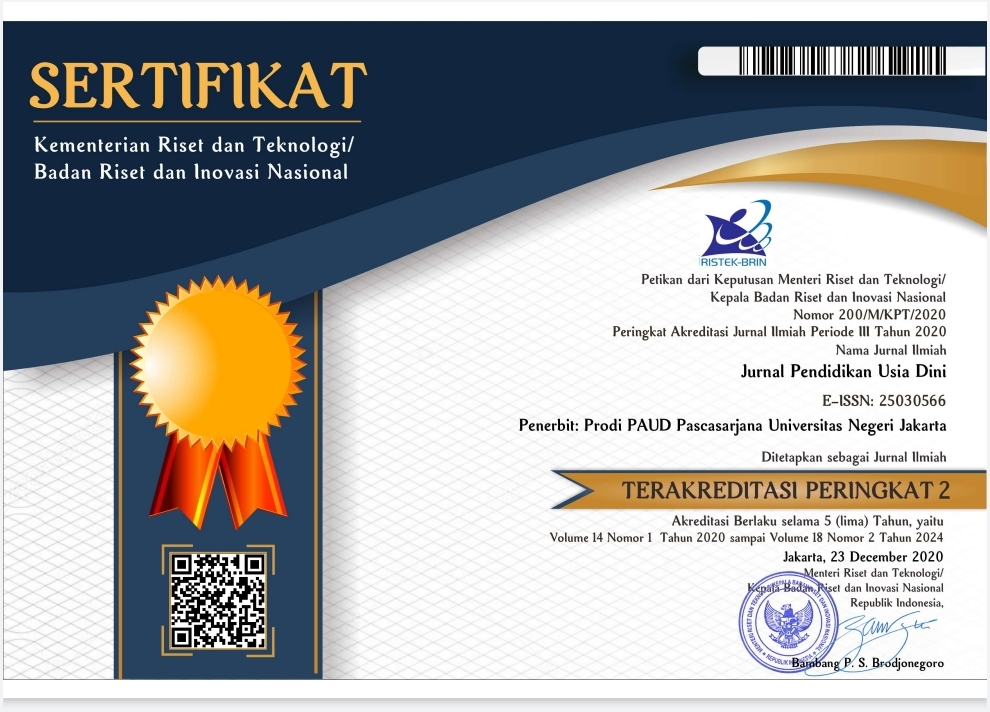Reading Children's Drawings Through Analysis of Three Metafunctions
DOI:
https://doi.org/10.21009/JPUD.161.13Abstract
For researchers, early childhood educators, and art educators, the contribution of this article is to expand meaning in drawing activities. Perspective in reading pictures using visual culture theory, especially visual grammar. This study aims to share knowledge and experiences in reading early childhood pictures from different perspectives. This research method uses a qualitative descriptive approach through visual material data collection techniques and analysis of three metafunctions. The objects of research are three pictures of children aged 7-8 years, namely the works of winners of the I-III children's painting competition held by PP-IPTEK TMII in 2018. Aspects of the representation structure, interaction system, and composition of each image are analyzed. The research findings conclude that the ideational function of the three images shows a narrative structure of representation and raises the discourse of resistance to the actual situation. The interpersonal function of the three images places the image maker in the real world and as an object of display impersonally. The textual functions of the three images position social life on other planets as a reflection of hope for real social life.
Keywords: children's drawings, visual culture, visual system, three metafunctions
References:
Butler, S., Gross, J., & Hayne, H. (1995). The Effect of Drawing on Memory Performance in Young Children. Developmental Psychology, 12. https://doi.org/10.1037/0012-1649.31.4.597
Creswell, J. W. (2015). Educational research: Planning, conducting, and evaluating quantitative and qualitative research (Fifth edition). Pearson.
de Lautour, N. (2020). The Visual Arts and Children’s Thinking and Theorising in Early Childhood. Www.Elp.Co. Nz/Articles, 13.
Driessnack, M., & Furukawa, R. (2012). Arts-based data collection techniques used in child research. Journal for Specialists in Pediatric Nursing, 17(1), 3–9. https://doi.org/10.1111/j.1744-6155.2011.00304.x
Elliot W, E., & D. Day, M. (2004). Handbook of Research and Policy in Art Education (1st Edition). Routledge.
Everts, H., & Withers, R. (2006). A Practitioner Survey of Interactive Drawing Therapy as Used in New Zealand. 16.
Freedman, K. J., & Stuhr, P. L. (2004). Curriculum Change for the 21st Century: Visual Culture in Art Education.
Funch, B. S. (1996). The aesthetic experience as a transcendent phenomenon. Nordisk Psykologi, 48(4), 266–278. https://doi.org/10.1080/00291463.1996.11863884
Gernhardt, A., Rübeling, H., & Keller, H. (2013). “This Is My Family”: Differences in Children’s Family Drawings Across Cultures. Journal of Cross-Cultural Psychology, 44(7), 1166–1183. https://doi.org/10.1177/0022022113478658
Hirsh-Pasek, K., Zosh, J. M., Golinkoff, R. M., Gray, J. H., Robb, M. B., & Kaufman, J. (2015). Putting Education in “Educational” Apps: Lessons from the Science of Learning. Psychological Science in the Public Interest, 16(1), 3–34. https://doi.org/10.1177/1529100615569721
Hwang, G.-J., Lai, C.-L., & Wang, S.-Y. (2015). Seamless flipped learning: A mobile technology-enhanced flipped classroom with effective learning strategies. Journal of Computers in Education, 2(4), 449–473. https://doi.org/10.1007/s40692-015-0043-0
Jolley, R. P. (2009). Children and Pictures: Drawing and Understanding. Wiley. https://books.google.co.id/books?id=QpGS9s9zqMoC
Kellogg, R. (1973). Misunderstanding Children’s Art. Art Education, 26(6), 7–9. https://doi.org/10.1080/00043125.1973.11652137
Knight, L. (2008). Communication and Transformation through Collaboration: Rethinking Drawing Activities in Early Childhood. Contemporary Issues in Early Childhood, 9(4), 306–316. https://doi.org/10.2304/ciec.2008.9.4.306
Kress, G. R., van Leeuwen, T., & Van Leeuwen, D. H. S. S. T. (1996). Reading Images: The Grammar of Visual Design. Routledge. https://books.google.co.id/books?id=vh07i06q-9AC
Kucirkova, N. (2017). IRPD—A framework for guiding design-based research for iPad apps. British Journal of Educational Technology, 48(2), 598–610. https://doi.org/10.1111/bjet.12389
Lowenfeld, V. (1949). Creative and Mental Growth. Macmillan. https://books.google.co.id/books?id=x7tRAQAAMAAJ
Mamur, N. (2012). The Effect of Modern Visual Culture on Children’s Drawings. Procedia - Social and Behavioral Sciences, 47, 277–283. https://doi.org/10.1016/j.sbspro.2012.06.651
Moerdisuroso, I. (2017). Social Semiotics and Visual Grammar: A Contemporary Approach to Visual Text Research. International Journal of Creative and Arts Studies, 1(1), 80. https://doi.org/10.24821/ijcas.v1i1.1574
Nielsen, A. M. (2012). Forskeres arbejde med oplevelser af børns tegninger som forskningsmetode [The researcher’s work with children’s experiences of drawing as a research method]. Psyke & Logos.
Papadakis, S., & Kalogianakis, M. (2020). A Research Synthesis of the Real Value of Self-Proclaimed Mobile Educational Applications for Young Children. In Mobile Learning Applications in Early Childhood Education (pp. 1–19). IGI Global. https://doi.org/10.4018/978-1-7998-1486-3.ch001
Quaglia, R., Longobardi, C., Iotti, N. O., & Prino, L. E. (2015). A new theory on children’s drawings: Analyzing the role of emotion and movement in graphical development. Infant Behavior and Development, 39, 81–91. https://doi.org/10.1016/j.infbeh.2015.02.009
Santrock, J. W. (2011). Educational Psychology. McGraw-Hill Medical Publishing. https://books.google.co.id/books?id=M8S4kgEACAAJ
Vygotski, L. S. (2004). Imagination and Creativity in Childhood. Journal of Russian & East European Psychology, 42(1), 7–97. https://doi.org/10.1080/10610405.2004.11059210
Downloads
Published
How to Cite
Issue
Section
License
JURNAL PENDIDIKAN USIA DINI work is licensed under a Creative Commons Attribution 4.0 International License. (http://creativecommons.org/licenses/by/4.0/)





